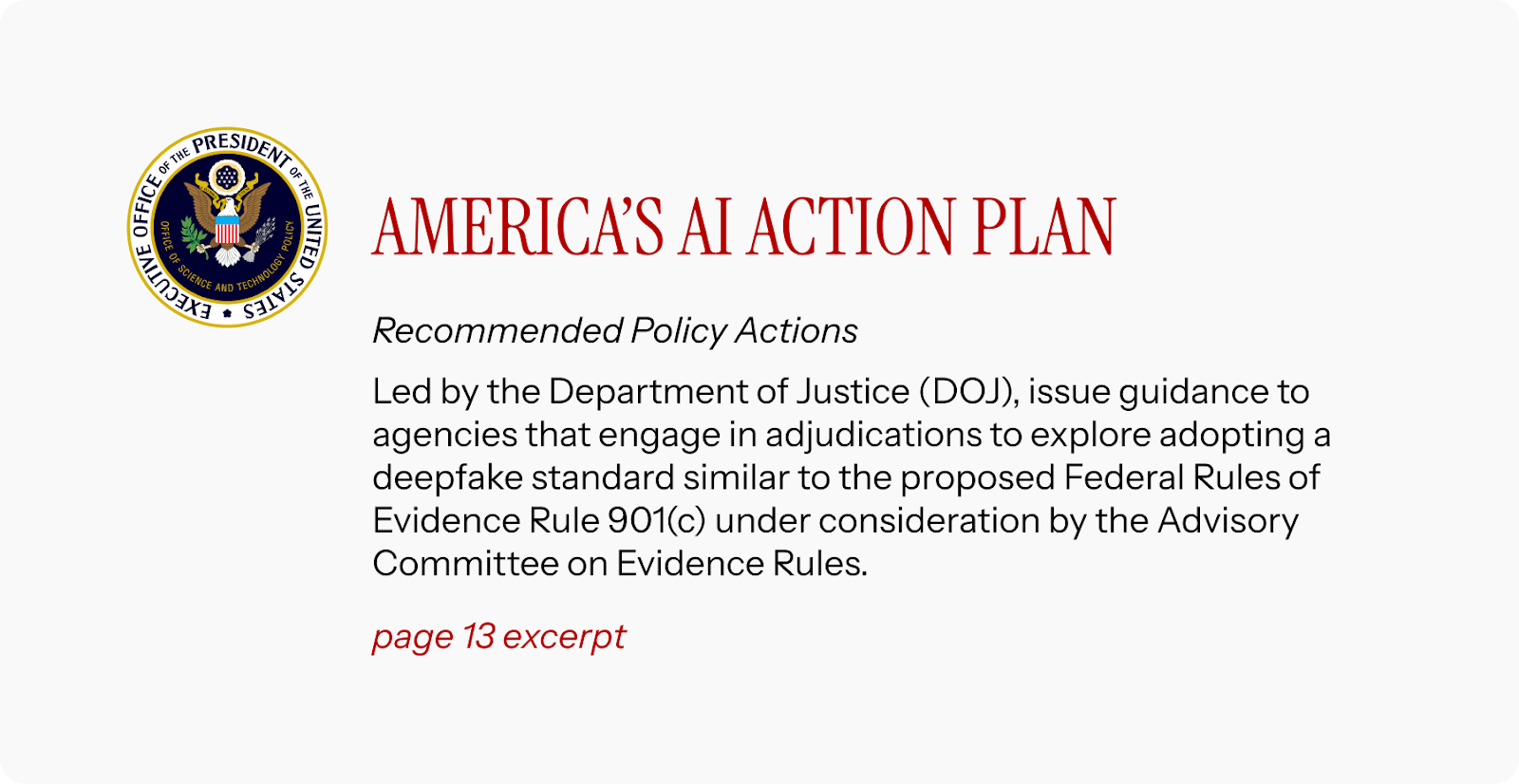TRUEPIC BLOG
AI Action Plan accelerates AI development, highlights risks to legal system
.png)
As the U.S. charts its course for advancing innovation, the newly released America’s AI Action Plan outlines a vision of AI development and adoption across sectors. While experts continue to digest the implications of the plan, which aims to accelerate U.S. economic and global leadership in AI, one section stands out as often overlooked: Combating Synthetic Media in the Legal System.
The inclusion of this section signals a notable acknowledgment of AI risk to our legal and economic systems. As AI-generated content becomes easier to produce and harder to detect, the legal system faces new vulnerabilities when digital content is used as proof throughout legal proceedings. The threat of falsified or manipulated media being introduced into evidence, whether through AI-generated images, edited videos, or fabricated metadata, has grown significantly. The time is now for U.S. courts, law enforcement, and the broader legal infrastructure to recognize and utilize image and data authentication tools for validating the integrity of digital media.
Image and data authentication matter right now
The plan outlines steps to support the detection of deepfakes and synthetic media after they surface in legal proceedings. Programs such as NIST’s Guardians of Forensic Evidence and the proposed Department of Justice (DOJ) guidelines are encouraging developments and steps in the right direction. However, waiting to detect falsified content after it enters the system is not enough.

Authenticating digital media must start at the point of content creation. Legal institutions, insurers, financial firms, and other entities that rely on documentation and visual content for adjudication require reliable methods of verifying whether the images and data they receive are tamper-free and trustworthy. Without this assurance, AI-driven fraud will continue to exploit even the most sophisticated digital workflows.
Expert comment
“The authentication provisions of the Federal Rules of Evidence used to be straightforward. They have made it very easy to admit an image or video and prior to deep fakes, there was little risk to this. And until recently, no one has thought this was problematic. We relied on juries to address the remote possibility that an image had been doctored.
"Now alterations in images and video are quite difficult to impossible to discover by ordinary inspection. Content authenticity and provenance provide a mechanism for ensuring the accuracy of this sort of evidence.
As we think about how to alter the rules of evidence in light of modern risks of manufactured evidence, courts should regard images and video so verified as presumptively admissible and juries should be instructed about the near-mathematical impossibility of the digital evidence having been fraudulently manufactured.”
- Wesley Oliver, Law and Computing Program Director, Marie-Clement Rodier, C.Sp. Endowed Chair and Professor of Law, Duquesne University
The case for securing digital content at the source
Tools like Truepic Vision are built to meet this challenge by verifying that images and videos are authentic and unaltered from the moment high-resolution imagery is captured. By cryptographically securing metadata such as time, date, geolocation, and device details, Vision provides an authenticated audit trail of data from the outset. This type of verifiable media is increasingly vital for businesses whose operations rely on the legal system.
Consider insurers litigating fraudulent claims, financial institutions settling transaction disputes, or enterprises responding to regulatory investigations. In addition, government agencies may rely on authenticated imagery to document international events and aid, or in conflict zones and non-permissive environments to verify property damage for expedited disaster relief. Law enforcement teams could benefit from authenticity tools during evidence collection to ensure the digital files withstand scrutiny during trials. Courts could also leverage real-time authentication for securely recording remote legal transactions. In each of these cases, the ability to provide authenticated content can help accelerate resolutions and support lawful outcomes.
As AI-generated content increases at scale, the burden of proof will shift. Legal and regulatory bodies should expect digital content to come with authentication safeguards rather than relying solely on downstream forensic analysis. That shift will help prevent synthetic media from influencing legal decisions while also enabling businesses to operate with greater confidence.
Looking toward industry standards and collaboration
The plan emphasizes the need for voluntary standards and interagency coordination. At the same time, private sector tools and frameworks will play an important role. Technical standards, such as the Coalition for Content Provenance and Authenticity (C2PA), provide a foundation for cryptographically secure approaches to ensure content complies with authenticity specifications as the digital ecosystem evolves.
By encouraging the use of authenticated content and supporting solutions that satisfy evidentiary requirements, both public and private stakeholders can uphold standards of trustworthy digital media.
Authenticated content in an increasingly synthetic world
The AI era is reshaping how digital evidence is created, evaluated, and exhibited. While the AI Action Plan emphasizes technological innovation, it also highlights the importance of ensuring AI does not undermine trusted content within our most critical systems. One proven way to do this is to ensure image and data authentication tools are used to verify the integrity of digital transactions. When material images, videos, and documents can be verified, decisions are more informed and the authenticity of digital content can be secured.
Subscribe to Truepic updates
Stay up to date with our latest resources and articles.

